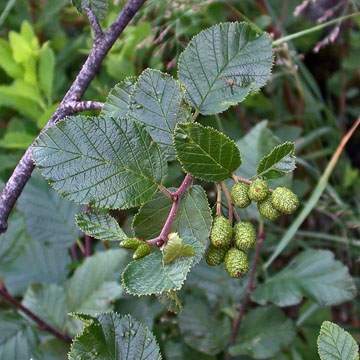

Alnus viridis - (image 1 of 4)
Taxonomy
Family: Betulaceae
Habitat
Bogs, shores, cold woods, in alpine and subalpine zones in the southern part of its range.
Associates
Distribution
Nearly circumboreal, south in North America to MA, NY, WI, MN, ID, and CA, and disjunct in PA and on Roan Mountain (NC-TN).
Morphology
Deciduous, colonial shrub; younger parts more or less glutinous; winter buds sessile, acuminate, with about 5 imbricate scales; leaves glutinous beneath when young, broadly elliptic to ovate, broadly obtuse to rounded or subcordate at the base, with mostly 6-9 main veins on each side, green and shiny (not glaucous) beneath, finely and sharply toothed, or almost laciniate; catkins appearing with the leaves, the pistillate catkins with 2-3 leaves at the base, at maturity 1-1.5 cm and evidently slender-pedunculate; filaments 0.5-1 mm; fruit 2-3 mm, the body only 1-2 mm wide and surround by a broad, pale, membranous wing.
Notes
Flowers March to April
Wetland Indicator: FAC
This North American subspecies is unique in that it produces long shoots in addition to short shoots that bear the leaves. It differs from other alders in having broadly winged fruits and sessile winter buds.
References
Gleason, Henry A.
and A. Cronquist. 1991. Manual of Vascular Plants of Northeastern United States
and Adjacent Canada. Second Ed.
The New York Botanical Garden. Bronx, NY
|
© Michael Hough 2004 |